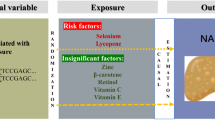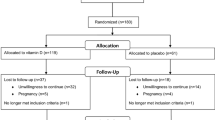Abstract
Objective
Epidemiological studies have shown that circulating sex hormone-binding globulin (SHBG) levels are lower in metabolic syndrome (MetS) patients than in non-MetS individuals. In this study, we investigated the relationship of polymorphisms in the SHBG gene with the serum SHBG levels and MetS in Han Chinese.
Methods
We performed a cross-sectional study of 316 subjects who were recruited from a health checkup population at Zhongshan Hospital, Fudan University. Anthropometric measurements, blood pressure, fasting plasma glucose, lipid levels, total testosterone, and SHBG levels were obtained in addition to the seven SHBG single-nucleotide polymorphisms (SNPs).
Results
The variant allele (AG or AA) carriers in rs6259, compared to the wild-type allele carriers (GG), have a lower risk for MetS [OR 0.56, 95 % confidence interval (CI) 0.33–0.96] and higher serum SHBG and TT levels (P = 0.016, 0.004). CT or TT allele carriers in rs3760213, compared to CC allele carriers, also have a lower risk for MetS (OR 0.59, 95 % CI 0.34–1.00) and significantly higher SHBG and TT levels (P = 0.029, 0.009). Carriers having both of the variant alleles had the lowest risk of MetS (OR 0.51, 95 % CI 0.275–0.950) and the highest SHBG levels. The risk of MetS rose with the decrease in serum SHBG levels for rs6259 and rs376021 carriers.
Conclusion
rs6259 and rs3760213 SNPs are associated with the risk of MetS and lower serum SHBG level in Chinese Han males.


Similar content being viewed by others
References
Cleeman JI, Grundy SM, Becker D et al (2001) Executive summary of the third report of the national cholesterol education program (NCEP) expert panel on detection, evaluation, and treatment of high blood cholesterol in adults (Adult Treatment Panel III). JAMA 285:2486–2497
Andreassi MG (2009) Metabolic syndrome, diabetes and atherosclerosis: influence of gene–environment interaction. Mutat Res Fundam Mol Mech Mutagen 667:35–43
Rosner W, Hryb DJ, Khan MS et al (1999) Sex hormone-binding globulin mediates steroid hormone signal transduction at the plasma membrane. J Steroid Biochem Mol Biol 69:481–485
Hammes A, Andreassen TK, Spoelgen R et al (2005) Role of endocytosis in cellular uptake of sex steroids. Cell 122:751–762
Kahn SM, Hryb DJ, Nakhla AM et al (2002) Sex hormone-binding globulin is synthesized in target cells. J Endocrinol 175:113–120
Ukkola O, Rankinen T, Gagnon J et al (2002) A genome-wide linkage scan for steroids and SHBG levels in black and white families: the HERITAGE family study. J Clin Endocrinol Metab 87:3708–3720
Wickham ER, Ewens KG, Legro RS et al (2011) Polymorphisms in the SHBG gene influence serum SHBG levels in women with polycystic ovary syndrome. J Clin Endocrinol Metab 96:719–727
Eriksson AL, Lorentzon M, Mellstrom D et al (2006) SHBG gene promoter polymorphisms in men are associated with serum sex hormone-binding globulin, androgen and androgen metabolite levels, and hip bone mineral density. J Clin Endocrinol Metab 91:5029–5037
Safarinejad MR, Shafiei N, Safarinejad S (2011) Association of the (TAAAA)n repeat and Asp327Asn polymorphisms in the sex hormone-binding globulin (SHBG) gene with idiopathic male infertility and relation to serum SHBG concentrations. J Steroid Biochem Mol Biol 123:37–45
Zhang B, Beeghly-Fadiel A, Lu W et al (2011) Evaluation of functional genetic variants for breast cancer risk: results from the Shanghai breast cancer study. Am J Epidemiol 173:1159–1170
Tsilidis KK, Travis RC, Appleby PN et al (2012) Interactions between genome-wide significant genetic variants and circulating concentrations of insulin-like growth factor 1, sex hormones, and binding proteins in relation to prostate cancer risk in the National Cancer Institute Breast and Prostate Cancer Cohort Consortium. Am J Epidemiol 175:926–935
Napoli N, Varadharajan A, Rini GB et al (2009) Effects of polymorphisms of the sex hormone-binding globulin (SHBG) gene on free estradiol and bone mineral density. Bone 45:1169–1174
Ding EL, Song YQ, Malik VS et al (2006) Sex differences of endogenous sex hormones and risk of type 2 diabetes—a systematic review and meta-analysis. JAMA 295:1288–1299
Ding EL, Song Y, Manson JE et al (2009) Sex hormone-binding globulin and risk of type 2 diabetes in women and men. N Engl J Med 361:1152–1163
Perry JR, Weedon MN, Langenberg C et al (2010) Genetic evidence that raised sex hormone binding globulin (SHBG) levels reduce the risk of type 2 diabetes. Hum Mol Genet 19:535–544
Thompson DJ, Healey CS, Baynes C et al (2008) Identification of common variants in the SHBG gene affecting sex hormone-binding globulin levels and breast cancer risk in postmenopausal women. Cancer Epidemiol Biomarkers Prev 17:3490–3498
Xita N, Milionis HJ, Galidi A et al (2011) The (TAAAA)n polymorphism of the SHBG gene in men with the metabolic syndrome. Exp Clin Endocrinol Diabetes 119:126–128
Ohlsson C, Wallaschofski H, Lunetta KL et al (2011) Genetic determinants of serum testosterone concentrations in men. PLoS Genet 7:e1002313
Matthews D, Hosker J, Rudenski A et al (1985) Homeostasis model assessment: insulin resistance and beta-cell function from fasting plasma glucose and insulin concentrations in man. Diabetologia 28:412–419
Vermeulen A, Verdonck L, Kaufman JM (1999) A critical evaluation of simple methods for the estimation of free testosterone in serum. J Clin Endocrinol Metab 84:3666–3672
Grundy SM, Cleeman JI, Daniels SR et al (2005) Diagnosis and management of the metabolic syndrome—an American Heart Association/National Heart, Lung, and Blood Institute Scientific Statement. Circulation 112:2735–2752
Li C, Ford ES, Li B et al (2010) Association of testosterone and sex hormone-binding globulin with metabolic syndrome and insulin resistance in men. Diabetes Care 33:1618–1624
Rodriguez A, Muller DC, Metter EJ et al (2007) Aging, androgens, and the metabolic syndrome in a longitudinal study of aging. J Clin Endocrinol Metab 92:3568–3572
Chubb SA, Hyde Z, Almeida OP et al (2008) Lower sex hormone-binding globulin is more strongly associated with metabolic syndrome than lower total testosterone in older men: the health in men study. Eur J Endocrinol 158:785–792
Selva DM, Hammond GL (2009) Peroxisome-proliferator receptor gamma represses hepatic sex hormone-binding globulin expression. Endocrinology 150:2183–2189
Turk A, Kopp P, Colangelo LA et al (2008) Associations of serum sex hormone binding globulin (SHBG) levels with SHBG gene polymorphisms in the CARDIA male hormone study. Am J Epidemiol 167:412–418
Vanbillemont G, Bogaert V, De Bacquer D et al (2009) Polymorphisms of the SHBG gene contribute to the interindividual variation of sex steroid hormone blood levels in young, middle-aged and elderly men. Clin Endocrinol (Oxf) 70:303–310
Haiman CA, Riley SE, Freedman ML et al (2005) Common genetic variation in the sex steroid hormone-binding globulin (SHBG) gene and circulating shbg levels among postmenopausal women: the multiethnic cohort. J Clin Endocrinol Metab 90:2198–2204
Ferk P, Teran N, Gersak K (2007) The (TAAAA)n microsatellite polymorphism in the SHBG gene influences serum SHBG levels in women with polycystic ovary syndrome. Hum Reprod 22:1031–1036
Riancho JA, Valero C, Zarrabeitia MT et al (2008) Genetic polymorphisms are associated with serum levels of sex hormone binding globulin in postmenopausal women. BMC Med Genet 9:112
Coviello AD, Haring R, Wellons M et al (2012) A genome-wide association meta-analysis of circulating sex hormone-binding globulin reveals multiple loci implicated in sex steroid hormone regulation. PLoS Genet 8:e1002805
Conflict of interest
None.
Author information
Authors and Affiliations
Corresponding author
Rights and permissions
About this article
Cite this article
Pang, XN., Yuan, Y., Sun, Y. et al. The relationship of sex hormone-binding globulin (SHBG) gene polymorphisms with serum SHBG level and metabolic syndrome in Chinese Han males. Aging Clin Exp Res 26, 583–589 (2014). https://doi.org/10.1007/s40520-014-0215-1
Received:
Accepted:
Published:
Issue Date:
DOI: https://doi.org/10.1007/s40520-014-0215-1




